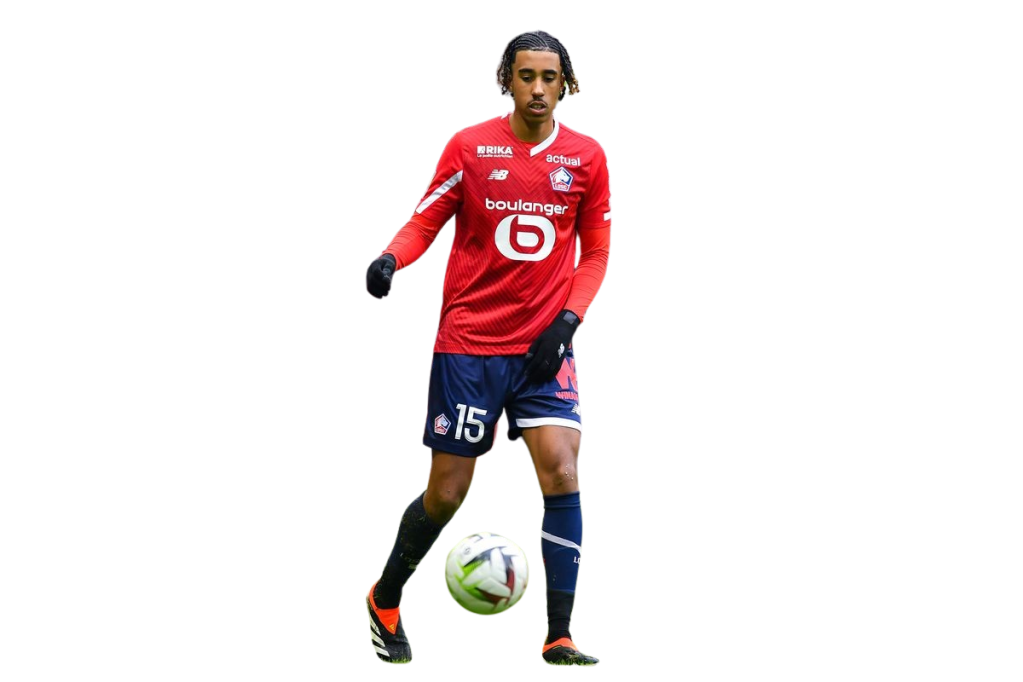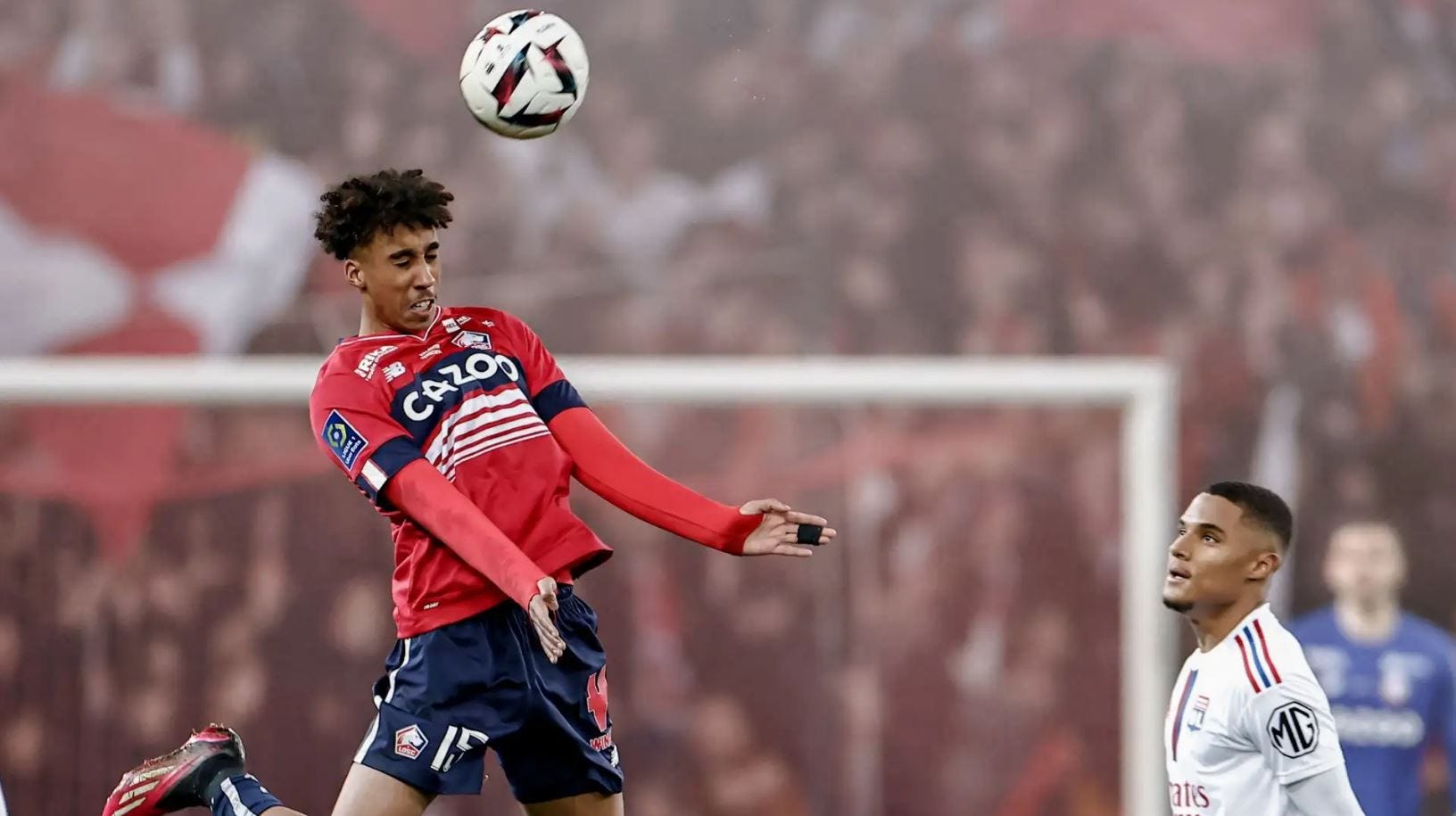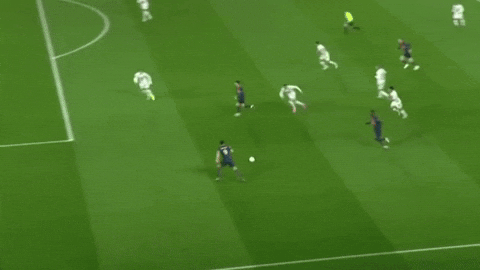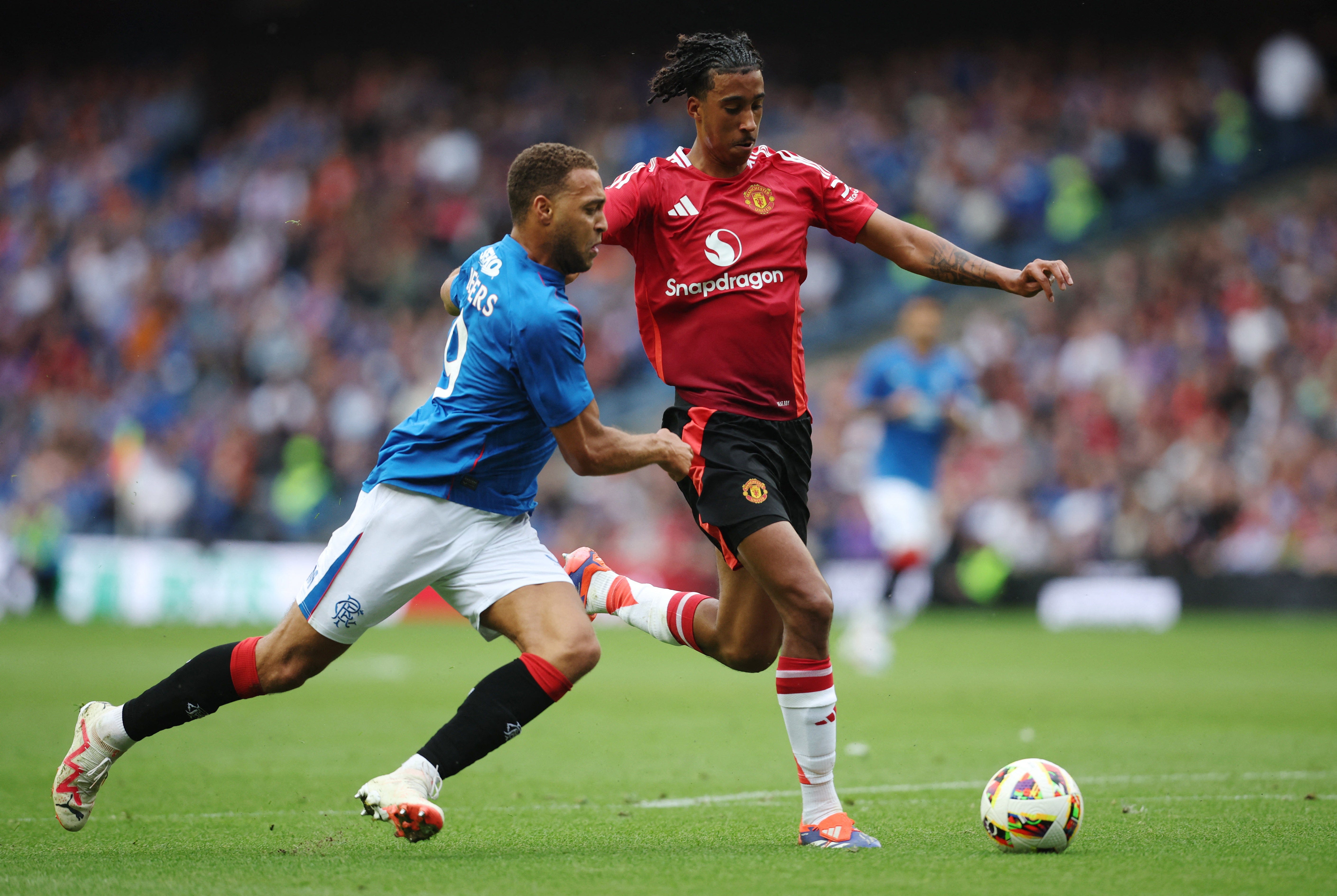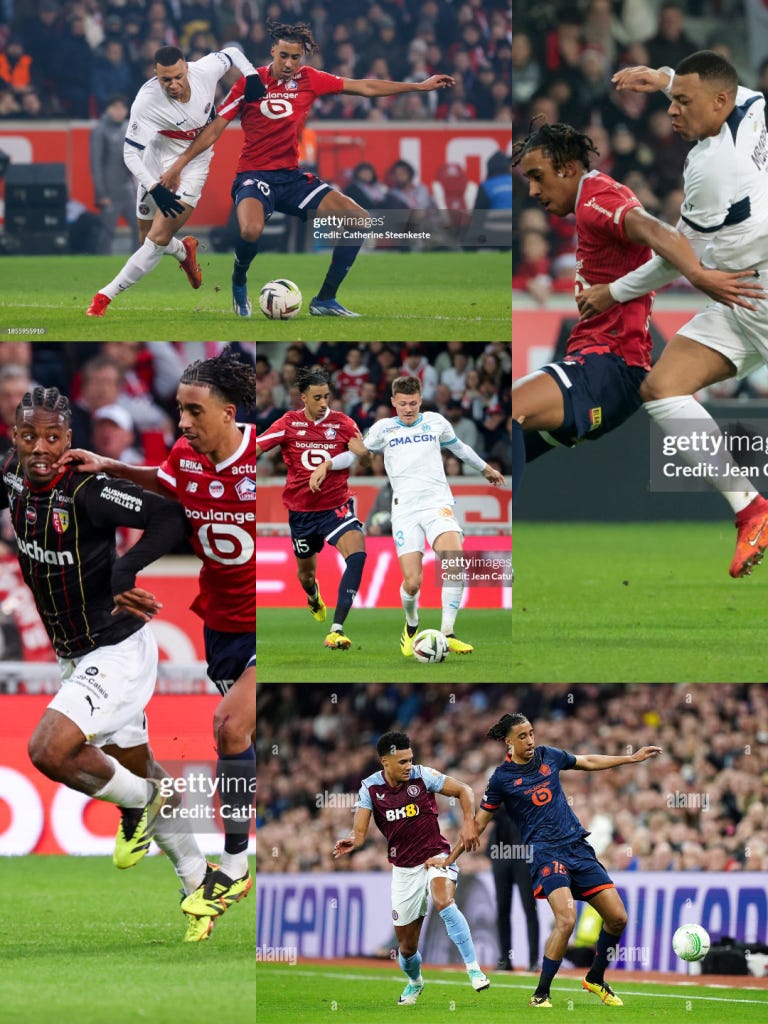This blog post is a trial-and-error-ish way for the author to improve his scouting/benchmarking skills by expanding on jotted bullet points concerning Leny Yoro's game.
Leny YORO (2005) is the subject of this short blog. Leny played in 46 Ligue 1 games after debuting at 16 years old - a relevant scouting cue being that Yoro was lined up as a centre-back; academy alumni in central defense often are deployed at full-back to get similar experiences of senior games but at relatively lower risk.
It is a testament to the scaling of Leny Yoro's game to the senior level - the mechanics of which this post delves into.
Leny Yoro's unique trait is perhaps the rare combination of the tall frame (190cm - 6ft 3in), the agile movements and his strong ground duels - a rare formula at the centre-back position, but for the lanky CB profile. He is also quick.
This blog reaches into five main topics, some because of their perpetual importance to the position, while others may be a (potential) standout trait of Yoro.
Heading
The (seemingly permanent) paradox of talent development in football is the dissonance between what is learned (through environment and experience) in development, and what is needed in the senior game.
It's where goalkeepers that have played with older players face hard strikes and become better at punching away shots rather than catching them. Or in the case of players of Yoro's size, who had an earlier growth spurt or are generally taller; who don't learn to jump high efficiently and head the ball, because they don't need to.
The exception to the rule is Romelu Lukaku (13 years old in this picture), who was rolling defenders then but also now at 31. To be fair, he debuted in the Jupiler Pro League at 16, and the Premier League at 18.
The reality of Leny Yoro's game from August onwards will be that Premier League teams launch balls into the air for him to compete with. It is of utmost importance that a partner of probably Lisandro Martinez is dominant in the air to not be a sieve for long balls. They will not only test you in the first opening games of the season (remember Welbeck and Toney in 2022/2023?), they will continue to do so until you have a Maguire-like contestant or an Amadou Onana in front of them.
Leny Yoro is a good header of the ball, and therefore a light exception to the paradox of development. Despite the length, Yoro's leap is surprisingly sufficient (unlike, say, Weghorst).
There's roughly five assets to dominating (or not failing) in the air:
Claiming your stake: unless you duel an absolute freak (it's the Premier League, some of them run around), the player that puts themself in the most comfortable position to compete for the ball usually wins the duel.
That involves accurately gauge the ball flight, using your legs to stand your ground, using your arms to put the opponent off their comfortable spot.Timing: in combination with claiming your ground and keeping the opponent as close to the ground as possible, you need to rise as high as possible at the right moment. The best timing is when you meet the ball at the highest position possible. Players that jump too early come down to the ground, in sync with the ball.
Jumping: the leap itself is not a standardized counter-movement jump (CMJ), you're keeping an opponent down too, who is keeping you down. This requires strength to perform.
Heading: the actual connection you make with the ball, with the forehead for the bullet header, not the top of the head. There's of course multiple connections, Yoro seems great at flicking the headers on. This is useful with 'flat' long balls he can head back to the goalkeeper, or on attacking set-pieces.
Direction: getting the direction right consistently is the ultimate goal; no point in claiming your centre-back is actually "okay enough" at headers when every header is a ball into the feet of the opponents. Traditional coaching point is to clear the ball out of the "funnel", out of danger.
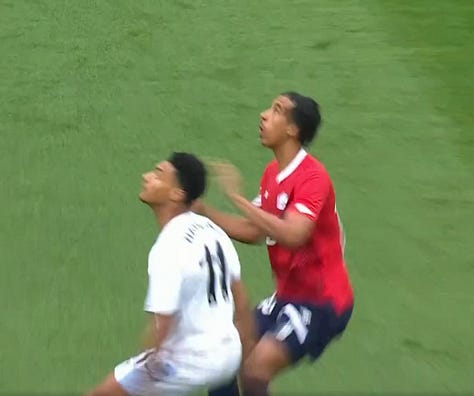
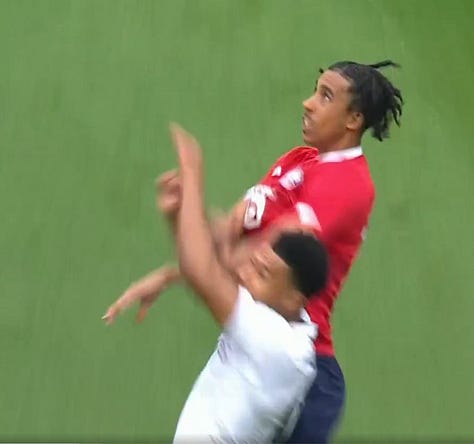
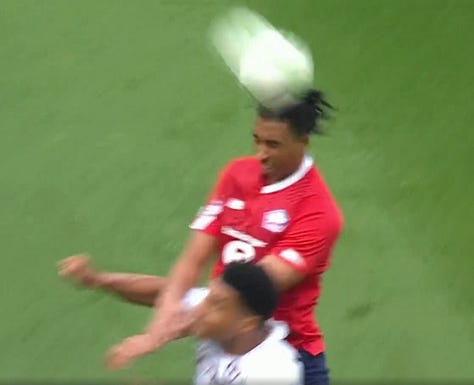
Those are Leny's two recorded aerial duels against Ollie Watkins. On both occasions, Yoro is in the better position, without shoving or nudging the opponent. That doesn't seem to actually be Yoro's intention in aerial duels. He focuses on reading the flight correctly, which he does.
That's also a very solid form on heading the ball (arms tense over the opponent) with clean contact (and direction) with the ball.
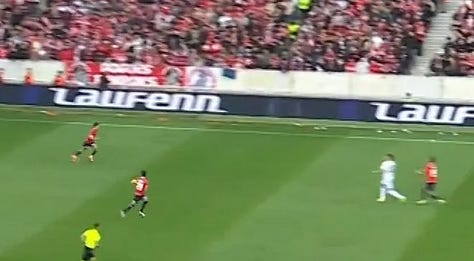

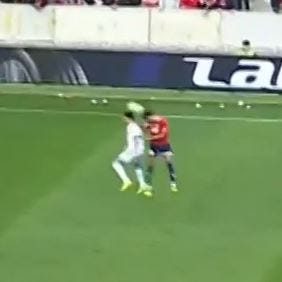
His leap is genuinely impressive for his build, which allows him to even lean over the opponent. That's a valuable tool to stop the ball from getting over/behind him.
It will be interesting for myself to follow whether he will add the nudge to his game to claim his ground when he's not in the best position.
A final scouting cue; Yoro is used as the central header in LOSC Lille's zonal defensive corner set-up. The first header (at the first post) is usually the one who heads the flat ball away first, while the other two (centre and back post) are deemed reliable by their coaches under contact and in dealing with the "falling" ball.
Agility
This is not a benchmarked centre-back requirement, in my opinion, but it is a standout trait for Leny Yoro.
The first feature Premier League strikers will notice when stepping on the same green as Leny is the long limbs, especially the legs. Players of that archetype - think Aaron Wan-Bissaka, Amadou Onana - develop the skill to wrap their legs around to reach the ball with either a straight or scissor tackle.
Those sliding tackles are quite precise. The reach is impressive, even though I personally feel Yoro still has more to offer using this tool.
In stepping out (tracking your forward dropping deep), I feel Yoro could call on this tool with more effect - to wrap around (and create a blockade) and either stop the ball or opponent from passing through.
An honourable mention to Yoro's physical game - he is extremely fast. That's also quite the tool in football.
Along with the next compartiment, it is also important to mention Yoro is a quick mover, and is unlikely to get flat-footed or spun around - considering his body build.
Not many lanky players figure that out before 25, let alone 18.
Ground duels
As established in the intro, playing double digits of games at centre-back before turning 18 in a combatitative league such as Ligue 1 is a valuable cue.
The first entry point to play at centre-back is to not be unreliable (yes, looking at you Alexsandro Ribeiro, who gave away two goals before the 17th minute after leading 0-1 at the Parc Des Princes in February 2024 as Leny Yoro's centre-back partner).
After not being unreliable, the top levels defenders are separated on the quantity (repetition) and potential standout qualities, which coaches consider assets to building a squad, or a balanced XI.
Yoro is surprisingly solid at his age (everyone will have screen time in the fail compilations, mind). It is not uncommon for tall and lanky players to seemingly move on ice skates early on in their senior careers.
But Yoro's defensive work is definitely good enough. There's the balance, that you achieve by keeping your shoulders over your feet, and not place your feet wider than your shoulders' width. These mechanics allow you to quickly and dynamically shift your feet, matching the attacker's speed and intent.
Yoro manages to stay very active and dynamic on his feet, and is surprisingly nimble/agile when turning in this posture. That's something relatively exclusive to the profile of a lanky centre-back.
He is not world-class in these sequences, which is okay. The main margin of improvement is likely to be found in (1) forcing the opponent wide and (2) reading the acceleration of the attacker.
Most wide (and central) attackers are excellent at slowing play and dragging the ball, in order to then explode into space. In those moments, Leny needs his solid defensive footwork, but also the ability to match the acceleration in order to block the angle towards goal.
That's a question of being on par through footwork and posture, reading the acceleration, sort of matching the acceleration, and covering the angle.
Leny Yoro's potential advantage is, just as Wan-Bissaka's, his legs that can reach that extra snippet to smother a shot.
Box and Channel Defending
The reality is that the box is the most important zone in football, and in the Premier League, it's do or die. Your Ollie Watkins and Ivan Toney's of this world gladly look at their upcoming centre-back opponents to get a sense of how much they can ragdoll them.
These players come alive in the box, and as a defender you cannot let them get a sniff, let alone the feeling they can/will grow in the game. That's game management - managing the score, the emotion and the timings within the game.
Some defenders are used to getting ragdolled, and resort to aggressive tackling as a response. From the footage I have watched, Yoro is reserved to go to ground, and is rather a polite defender.
And while that is no inherent problem, there is work to be done to play against your Everton's, Aston Villa's, Brentford's, Crystal Palace's, ...
This is good, though, to nudge and annoy the attacker when the referee is not watching. But Yoro will need to do this in the match-deciding moments too.
In that case I'm talking of using the stiff arm to disrupt the momentum of the attacker, and claim his ground. This is tugging the arm, hitting the opponent's arm the other way, in other to get the advantage while staying on your feet (by keeping the shoulders over your feet).
The skill Yoro can add is to grab onto the shirt, and not pull it down, but knead it into his grip - doing it out of the referee's view (by for example, using the attacker's body as a shield). The smart centre-back does this in the right context, and not inside the box (VAR check - penalty!) and not as the last defender.
It is not a wild assumption to think, due to Yoro's sweeping (last-man) role at LOSC Lille, this is a skill he hasn't had an abundance of development opportunities for.
As for inside the box, I have the gut feeling Yoro needs to pick a few tricks to a Premier League staple. He is not and will not be the Nemanja Vidić-archetype centre-back, but he does need to boss the box.
The biggest step yet is to constantly search for (legitimate) contact in the penalty area.
You can never make a Premier League striker feel as if they're alone in the box, or they will run riot and not stop after scoring one.
Make contact in order to assert your presence, but also know where they are - and not get caught by double movements.
This is where I'll keep my eye on in Yoro's first Premier League games.
And the same is true in either the channels or in behind the defense, contact is essential to break the opponent's momentum, delay the attack, and never let them feel they're on top of you.
While being cautious considering development isn't linear and players aren't guaranteed to learn new skills, I expect Manchester United's coaching staff to work on this. Because it is easy to identify, and will be fundamental in order to not lose Premier League strikers in the box.
Progressing the ball
Getting the ball up the pitch is one of the tasks of centre-backs, and while not as important as the aforementioned topics (which determine whether strikers enjoy playing against you), it has its obvious use.
Yoro is rather the passer than the carrier of the ball. And while his passing may not be the absolute top-end in his position, it is certainly solid and sustainable. I will not go over every carry and pass, but I will cherry pick what I found to be interesting.
A football pitch is about 100 metres long, and therefore, players that make the ball go the distance in a risk-averse and quick way will always be valuable - be it the player that can carry the ball, the player that can pass the ball long - or the players out of possession that can difuse the long pass or eat space to stop that carrying midfielder.
Leny Yoro has good variety in the ways he gets the ball up the pitch.
That is the falling ball. This pass travels slower, but is easier to control, and easier to keep on the pitch when creating a second ball (especially, laying off in support under the ball).
Yoro is genuinely excellent at these falling balls, which are hit more with the toes, and by quickly striking the locked ankle down into the ground. This creates the backspin that makes the ball fall.
Note: it is easy for players to hit this pass with much less pace. That's not the case with Yoro.
Another long ball type is the skipping ball, which is hit with the laces, and travels much faster. It dips too, but almost seems to accelerate after hitting the ground, skipping over the ground. That's less so the expertise of Leny Yoro.
LOSC Lille's long-passing burden lies more upon the shoulders of Nabil Bentaleb. This is no useless scouting cue - he can hit a pass in behind with appropriate height, speed and curve like neither of the centre-backs can. Therefore, you often see Yoro look for the short five-yarders to his centre-back partner or Bentaleb.
Conclusion
Premier League and UCL teams look for reliable players, players that deliver 7/10 performances every week on matchday (and in training). Yoro is one of those players, as your Maguires and McTominays.
Yoro is a special profile on top of that, because of the rare composition (tall, agile, fast and not unreliable). His skillset is not what sets him apart, but it is at the benchmark Premier League level already.
The premium price you indirectly (because of Real Madrid's shared interest in the player) is the price you pay for the athlete, keeping in mind only the biggest talents in football have more or less already put together their skillset at the age of 18.
Football has no shortage of talented players, but it does have a shortage of people that develop talent well, in addition to a shortage of pathways for said talent. Manchester United offer a pathway that interested Yoro; it remains to be seen how they develop it.
This will be interesting for the author to scale or benchmark his projections to the Premier League level, and how he handles the game in England. Especially in the case of what adaptations he makes to his skillset in order to compete.





